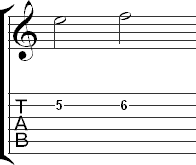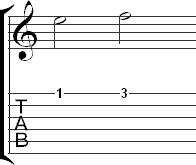What You Should Know
What You Will Learn
- How to spell the major scale
- The names of each scale degree in the major scale
- How accidentals work
How to Construct a Major Scale
What is a scale?
A scale is a collection of ascending or descending pitches arranged according to a specific pattern of intervals. There are many kinds of scales, including major, minor, pentatonic, and more. This lesson will cover the construction of the major scale.
The Major Scale
The major scale is a seven scale created using a specific pattern of whole and half steps. The root of the major scale is the first note in the scale. The root can also be determined from the name of the scale. For example, the root of a G major scale is G. Although the major scale has seven pitches, it is usually shown starting and ending on the root, which gives a total of eight pitches.
Whole Steps and Half Steps
A half step is the distance from one fret to the next fret on the same string. The fifth fret to the sixth fret on the B string is one example of a half step:

A whole step is the interval from one fret to the fret two frets up on the same string. For example, the distance between the first and third fret is a whole step.

The Pattern of Whole and Half Steps in the Major Scale
The major scale is constructed from a specific pattern of whole and half steps. Whole and half steps are intervals. If you have gone through the introductory lesson on intervals, you should know that a half step is also known as a minor second and a whole step is a major second. The pattern for the major scale is: Whole Whole Half Whole Whole Whole Half
The pattern is often abbreviated like this: W W H W W W H
The C major Scale
If you build a major scale using this pattern with C as the root, the result is a C major scale. This is shown below with the whole and half steps labeled:

The notes in the C major scale are C, D, E, F, G, A, B.
Scale Degrees
The notes in a scale are often referred to by their numeric order or degree in the scale. Scale degrees start with the number one beginning on the root of the scale. Here is the C major scale with each of the degrees labeled:

Names of the Scale Degrees
Each note in the scale also has a name:
| Degree | Name |
|---|---|
| 1 | tonic |
| 2 | supertonic |
| 3 | mediant |
| 4 | subdominant |
| 5 | dominant |
| 6 | submediant |
| 7 | leading tone |
A C major scale is shown below with each degree labeled:

These names are important and should be memorized. They are used extensively when constructing chords and chord progressions, so learning them now will benefit you later.
Accidentals
It is possible to build a major scale on all twelve pitches on the guitar. In order to do this, you need to raise or lower certain pitches to keep the pattern of whole and half steps the same for each scale. This is achieved through the use of accidentals. An accidental is a symbol that affects the pitch of a note by either raising it or lowering it. Two kinds of accidentals are used in major scales: sharps and flats.
Sharps
A sharp  raises the pitch of a note by one half step.
raises the pitch of a note by one half step.
Flats
A flat  lowers the pitch by one half step.
lowers the pitch by one half step.
Using Accidentals to Create Major Scales
It is important to spell accidentals correctly. It is often possible to call a note by several different names. For example, an F# can also be called Gb. These notes are known as enharmonic. They sound the same, but are called by different names. While the notes sound the same, you can't use the names interchangeably. Every letter in the musical alphabet should be used once. This means that every scale will use the letters A, B, C, D, E, F, and G, possibly with sharps or flats.
Major scales use only one kind of accidental. They may include sharps or flats, but no major scale includes sharps and flats within the same scale.
Every degree of the major scale should have its own letter name with no letters being repeated. Each letter of the musical alphabet should occur once in the major scale. The musical alphabet includes the letters A, B, C, D, E, F, and, G. If you reach G, you need to start over with A and continue until you complete the scale. For example, if you want to build a C major scale, you start on C. Continuing through the musical alphabet, you get C, D, E, F, G. In order to complete the scale, you need to continue through the musical alphabet starting again on A to get the complete scale of C, D, E, F, G, A, B.
It is important to remember this concept, so that you know what to call each note in a scale. For example, the third note in an A major scale should be called a C# instead of Db since there is also a D natural in that scale. Since D has already been used, the third note in the scale couldn't be a Db because each letter of the musical alphabet should only be used once.
Building an A Major Scale
Building a major scale on any pitch other than C necessitates adjusting certain notes in the scale either up or down to get the specific pattern of whole and half steps needed for the major scale. Try building a scale starting on A to see how this works. If you start on A without using any accidentals, you get the following (the errors in this scale are shown in red):

If you check the distance between each note, you should find the following problems:
- 1. The distance between the second (B) and third (C) notes is a half step. It should be a whole step.
- 2. The distance between the third (C) and fourth (D) notes is a whole step instead of a half step.
- 3. The interval between the fifth (E) and sixth (F) notes is a half step. This should be a whole step.
- 4. There should be a half step between the seventh degree (G) of the scale and the root (A) instead of a whole step.
Adding a C#
The first two problems can be corrected by raising the third degree of the scale by a half step using a sharp. C becomes C#, which creates a whole step between the second and third degrees and a half step between the third and fourth degrees of the scale.

Adding an F#
The third problem can be fixed by raising the F a half step to F#. This creates whole step between the fifth and sixth degrees of the scale.

Adding a G#
The addition of an F# has created another problem. There is now a half step between the F# and G. It was previously a whole step, which was the correct interval even though the actual notes were wrong. Luckily, the last change will correct both of the remaining issues with the pattern. The last problem can be fixed by raising the G a half step to G#. This makes the interval between the seventh degree and root a half step. It also fixes the interval between the fifth and sixth degree by making it a whole step.
The A major Scale
These changes result in the A major scale:

Exercises
Now that you know how to create a major scale, build a major scale on each of the following roots: C, G, D, A, E, B, F#, C#, Gb, Db, Ab, Eb, Bb, F. Note that several of the scales are enharmonic: F# and Gb major, and C# and Db major. Write out each scale using the scale worksheet provided below:
Try playing each major scale on the guitar as well. Pick a note on any string and build a major scale on that string. This is a great opportunity to learn the rest of the notes on the guitar. Since you only learned the natural notes previously, you will have to learn the names and locations of the remaining notes in order to play each scale. An example of this is shown below. An F major scale is built starting on the F on the first fret of the first string. Since this is a music theory exercise and not a technical exercise, just play each note in the scales with a single finger to make it easy.

